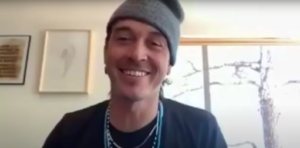Collective Art Practice, Rehumanization, and Catharsis: A Talk with Cannupa Hanska Luger
By: Lindsey Pannor, May 5, 2020
On April 16th, the Arts’ Research Center collaborated with UC Berkeley’s College of Letters and Science course titled “Public Art and Belonging” to host Cannupa Hanska Luger “on” campus—though, in light of the pandemic, this event occurred virtually on Zoom. Luger was kind enough to join us from the comfort of his New Mexico home and, with the aid of his website, tell us about his artistic processes and the projects which he has helped to facilitate as of late. Luger is of Mandan, Hidatsa, Arikara, Lakota, Austrian, and Norwegian descent, and was born on the Standing Rock reservation in North and South Dakota. The projects which he presented all concern, in some way, the lives of indigenous peoples’ and the violence which they face “everywhere where there are resources to be extracted.”
Luger’s work, as it reflected in the title of his talk, “Social Engineer: The Artist as Bridge Builder,” often attempts to take a single concept and size it up to scale, so that the collective body behind a statistic or data set is able to be realized in a concrete form. One of the most striking projects which he presented, set to be on view at the Hood Museum at Dartmouth this fall, is titled “Form & Relation.” It is a curtain of sorts, composed of over 4,000 handmade ceramic beads which are arranged to, from a bit of distance, represent a portrait of a native woman in the image of Luger’s collaborator Kali Spitzer’s photograph, titled “Sister.” As Luger explained during his talk, each bead is representative of an individual person who was either queer or trans, a girl or a woman Canadian native who has gone missing or been murdered. It is additionally meant to gesture towards the continued matricide of native peoples’ mother figures all over the world. He reemphasized time and time again that there is a sort of discomfort for him in presenting these projects alone, as “no one person can produce the kinds of results we have together.” He mentioned that a countless amount of people assisted in making these beads: at their kitchen tables, in their homes and other isolated spaces, sending them to him with letters and all kinds of care encompassed within.
Another poignant result of Luger’s projects which he discussed was, in building a bridge of sorts through these collectively engineered projects, each participant is able to experience both a sense of individual responsibility for the violence which continues to occur as well as a moment of catharsis in honoring and archiving its victims. Another project he presented, which is currently in the midst of its completion, is entitled “Something to Hold Onto.” It is similarly made of beads generated by a community, though these are much larger, created by a person’s hand grasping a hollowed piece of clay to create an “echo of something to hold on to” in what is otherwise an inhuman and relatively inaccessible data set. Similarly to “Form & Relation,” the project is driven by a single large number, this one representing those for whom attempting to cross the U.S.-Mexico border was “the end of the line.” Luger expressed a hope to eventually string these beads, of which there will be tens of thousands, along the border itself. He integrates those affective aspects of the project mentioned quite intentionally, as, for example, he will not be firing these beads in a kiln. “When you fire clay, it becomes something else, something that would outlive me,” he said. “I have to wonder if this is something that we want to retain.” That catharsis which inspired the making of the project itself is what Luger is looking to uplift when the project reaches its end, as the string of beads disintegrates along the violent border which they represent.
During the question and answer portion of his talk, Luger incidentally summed the powerful force which lies at the core of the art which he presented: “what is shared is the overall vision.” Art, to him, is a verb and thus a practice which is meant not for objectification and purchase as according to capitalism, but rather for being experienced by those it is relevant to. He mentioned that the beading project mentioned above is still underway—if you’re able to get your hands on the materials to create a bead, Luger has an open call active for “Something to Hold Onto” here. It is open through August 15, 2020.
You can also visit Luger’s website here, and watch the full talk on our YouTube channel here.
Lindsey Pannor is a writer and researcher based in Berkeley, CA. She holds a B.A. in English—as well as minors in Creative Writing and Journalism—from the University of California, Berkeley. She has held editorial positions for multiple publications including Zyzzyva and the Berkeley Poetry Review. She is currently ARC’s Program Assistant.

